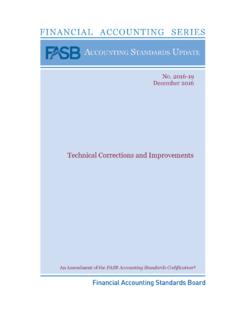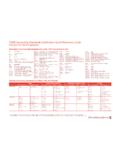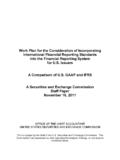Transcription of An examination of accounting for repurchase agreements
1 Journal of Finance and Accountancy Volume 19, March 2015 An examination of accounting , page 1 An examination of accounting for repurchase agreements Steven W. Smalt Kennesaw State University J. Marshall McComb II Kennesaw State University ABSTRACT repurchase agreements have been a source of debate in the last few years. In June 2014, the fasb released Transfers and Servicing (Topic 860), repurchase -to-Maturity Transactions, repurchase Financings, and Disclosures as an amendment to the fasb accounting standards Codification. This paper attempts to discuss the origin of repurchase agreements , financial statement manipulations using repurchase agreements , actions the fasb has taken to modify financial reporting standards to better clarify accounting treatments, and identify potential remaining accounting issues. Keywords: repurchase agreements , sale accounting , secured borrowings, repo-to-maturity, repo market Copyright statement: Authors retain the copyright to the manuscripts published in AABRI journals.
2 Please see the AABRI Copyright Policy at Journal of Finance and Accountancy Volume 19, March 2015 An examination of accounting , page 2 INTRODUCTON Financial reporting standards have been the focus of harsh criticism over the last few years as the economy has stalled. Many have assigned blame to lax accounting standards for allowing deceitful and dishonest practices to take place in the financial industry. Meanwhile, some have contended that the collapse of the financial industry in 2008 was due to overly complex financial standards which allowed open-interpretation by companies. This paper will examine one area of financial reporting in particular which has received criticism in recent years, repurchase agreements ( repos ). More specifically, we will focus on repo transactions that were accounted for as sales versus secured borrowings, namely repurchase -to-maturity transactions. Over the last decade these transactions became the backbone of the modern financial system.
3 Firms relied on repos to finance their everyday operations and this is why it is important to take a careful look at how we report these transactions. Repo transactions are not simply a minor esoteric backwater of the financial system for which rough and ready accounting will suffice. The repo market is at the heart of the global financial system (Chircop, Vicky Kiosse and Peasnell 2012). The objective of this research paper is to determine how firms used repos to manipulate financial reporting and improve financial positions, what deficiencies in the prior accounting treatment allowed these companies to manipulate their financial statements, and how the fasb addressed those deficiencies. As with most accounting reform, the motivation to improve accounting for repurchase agreements stems from a perceived failure by the fasb to adequately set forth clear guidelines for reporting of these transactions. According to data from the Federal Reserve, there was $ trillion of fixed income securities financed with repos by 2008 (Gorton and Metrick 2012).
4 This report also aims to determine what kind of impact the fasb s changes will have on industries that engage in repurchase agreement transactions. THE BASICS OF repurchase agreements A repurchase agreement , also known as a repo is defined as a form of short-term borrowing for dealers in financial assets (historically government securities). The dealer sells the financial assets to investors, while simultaneously agreeing to buy back the security at a specified price and specified time, typically on a short-term basis (Garbade and Fleming 2003). See Appendix for illustration. Fundamental to these instruments are a fixed buy and sell price coupled with a specified short term settlement date. The duration of the transaction is typically overnight but rarely no more than 14 days. In essence the structure of the transaction has the look and feel of a collateralized loan. (Federal Reserve Bank of New York 2007). According to Statement of Financial accounting standards (SFAS) 140 effective April 2001, the above transaction could be treated as either a secured borrowing or as a sale typically accompanied by a forward purchase agreement .
5 The standard defines a repurchase -to-maturity transaction as a repurchase agreement in which the settlement date of the agreement to repurchase a transferred financial asset is at the maturity date of that financial asset and the agreement would not require the transferor to reacquire the financial asset (FASB 2014). Journal of Finance and Accountancy Volume 19, March 2015 An examination of accounting , page 3 PRIMARY USERS Although many individuals and businesses indirectly benefit from the repo market by their use of money market and sweep accounts the parties directly involved in the repo agreements is generally limited to financial services entities. A typical repo transaction involves a borrower and a lender (seller and buyer). Central banks, hedge funds, mutual funds, broker dealers, and commercial banks are typical participants in these transactions. Other non-bank financial organizations have begun to enter the repo market since the financial crisis of 2008.
6 These risk averse institutions with excess cash are entering the market primarily because of the attractiveness of the features associated with the repos. Examples include pension funds, endowments, corporate treasuries, and insurance companies (International Capital Market Association ). ADVANTAGES OF REPOS The major advantages of participating in repo transactions flow directly from the use of government securities as collateral. The investor encounters very little risk that the dealer will refuse to honor the securities at the time of the repurchase . On the other hand, the dealer likes the ease with which the securities can be transferred. Most securities are held merely as bookkeeping entries at the Federal Reserve Bank, enabling them to be exchanged over the federal wire without any physical delivery. Consequently, repo transactions, which can be completed very quickly, provide sophisticated investors with features they seek most: liquidity, security, and good returns on their investments (Schatz1987).
7 The borrower typically receives a lower interest rate than the market long-term rate because of the unique features of the repo agreement , namely quality of collateral and short duration of the transaction. The lender benefits by being able to invest excess cash and earn a return on a short-term basis with very low risk of default. IMPORTANCE OF repurchase agreements IN FINANCIAL MARKETS repurchase agreements play key roles in the allocation of resources in financial markets. They provide an opportunity for financial institutions such as banks or mutual funds to lend excess funds on a short term basis in a secure manner. From the borrower s perspective, the repurchase agreements provide a relatively low cost source of short term financing. The importance of the repo market is suggested by its immense size: dealers with a trading relationship with the Federal Reserve Bank of New York so-called primary dealers reported financing $ trillion in Treasury, agency, mortgage-backed, and corporate securities at the end of 2002 with RPs (Garbade and Fleming 2003).
8 HISTORY Repos have been in use since the early 1900 s by Federal Reserve Banks to make loans to member banks. Although the Great Depression and World War II curtailed their use, they began to reemerge as a result of monetary policy in early 1950 s (K. D. Garbade 2006). In the early 1980s a few government securities dealers became insolvent and caused themselves and the other party engaged in the repurchase agreement with them to go bankrupt. Journal of Finance and Accountancy Volume 19, March 2015 An examination of accounting , page 4 After this happened, many companies began to seek greater credit protection and forced some change in the way repurchasing transactions were structured and secured. The result of this change was the birth of the tri-party repurchase agreement . In a tri-party repurchase agreement , an agent bank stands between the dealer and the creditor. A previously negotiated contract among the bank, the dealer, and the creditor describes the acceptable securities and the margins required on the securities.
9 At the start of a repo, the dealer delivers securities, and the creditor delivers funds, to the bank. After verifying that the securities are acceptable and have a market value that exceeds the principal amount of the repo by more than the required margin, the bank releases the funds to the dealer but continues to hold the securities as the creditor s custodial agent. At the end of the repo, the dealer returns the principal plus interest at the negotiated rate to the bank, the bank releases the securities back to the dealer, and the bank remits the principal and interest to the creditor (K. D. Garbade 2006). In 1983, the fasb issued statement No. 76, Extinguishment of Debt, and No. 77, Reporting by Transferors for Transfers of Receivables with Recourse to help guide and direct those who used repo agreements . In 1996, statement No. 125 accounting for Transfers and Servicing of Financial Assets and Extinguishments of Liabilities was issued further defining the reporting of transfers by saying A transfer of financial assets in which the transferor surrenders control over those assets is accounted for as a sale to the extent that consideration other than beneficial interests in the transferred assets is received in exchange.
10 The transferor has surrendered control over transferred assets if and only if all of the following conditions are met: 1. The transferred assets have been isolated from the transferor- put presumptively beyond the reach of the transferor and its creditors, even in bankruptcy or other receivership. 2. Either (1) each transferee obtains the right-free of conditions that constrain it from taking advantage of that right-to pledge or exchange the transferred assets or (2) the transferee is a qualifying special-purpose entity and the holders of beneficial interests in that entity have the right-free of conditions that constrain them from taking advantage of that right- to pledge or exchange those interests. 3. The transferor does not maintain effective control over the transferred assets through (1) an agreement that both entitles and obligates the transferor to repurchase or redeem them before their maturity or (2) an agreement that entitles the transferor to repurchase or redeem transferred assets that are not readily obtainable (Financial accounting standards Board 1996).














